As vaccinations jabbed into peoples’ arms in the U.S. continue to immunize health citizens from contracting the coronavirus, millions of folks are looking forward to getting back inside restaurants to enjoy meals out, as well as un-masking when grocery shopping.
But people in the U.S. love their food both outside and inside the home: about one-half of people in the U.S. are continuing to cook at home more, according to 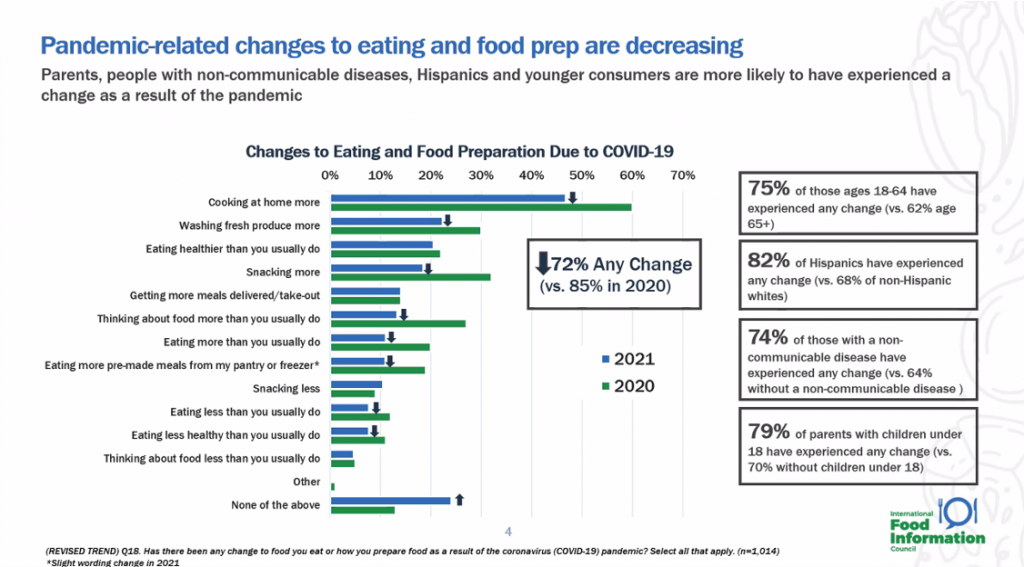 the 2021 Food & Health Survey published today by the International Food Information Council (IFIC).
the 2021 Food & Health Survey published today by the International Food Information Council (IFIC).
This sixteenth annual report is a go-to for those of us in the health/care ecosystem who knows that food is a social determinant of health.
For this year’s research, IFIC conducted an online survey among 1,014 Americans between 18 and 80 years of age in late March 2021.
The first bar chart tracks the year-on-year changes related to U.S. consumers and pandemic-era eating and food prep behaviors. Most changes people made a year ago at the start of the pandemic, such as washing fresh produce and food packages more, snacking more, and eating more, have lessened over the twelve months.
As 2020 was our Year of COVID, with long weeks and months of lock-down and quarantine coupled with working and learning from home, 2021 is our Year of Vaccinations — and reverting back to some of our old behaviors. But watch for certain new behaviors, like cooking at home and eating healthier than in the past, to persist post-vaccination and returning to work and school.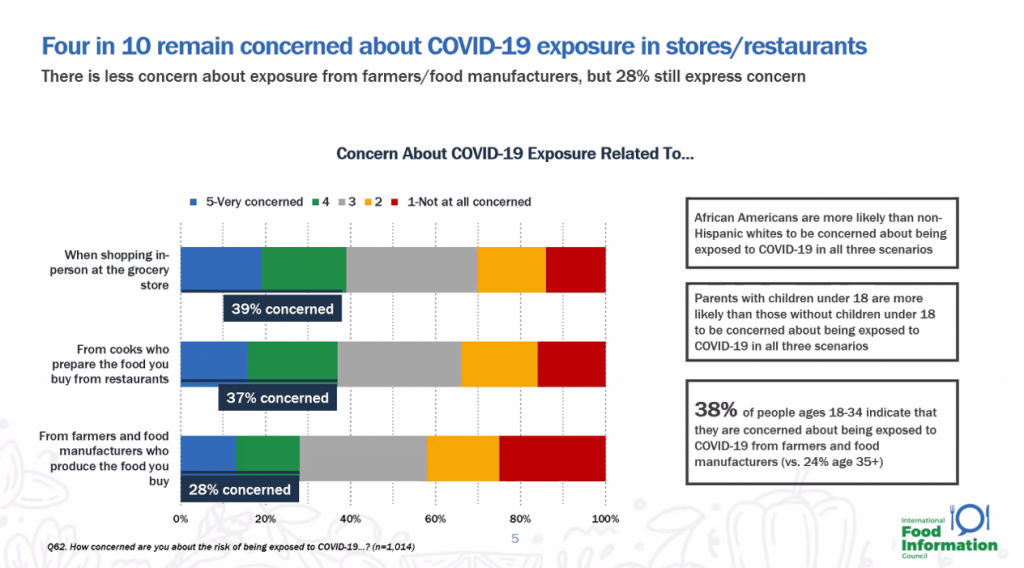 s
s
Even with wallets with cash itching to be spent on in-restaurant dining and prepared foods for carry-out, 4 in 10 U.S. consumers are still concerned about COVID-19 exposure in restaurants and retail food establishments. This second chart illustrates that.
Interestingly, fewer consumers are worried about virus exposure coming from the farmers and food manufacturers who produce the food people buy, shown in the bottom bar of this chart from the study.
African-Americans are more likely than Whites to be concerned about exposure across these three areas, and parents of kids under 18 are as well.
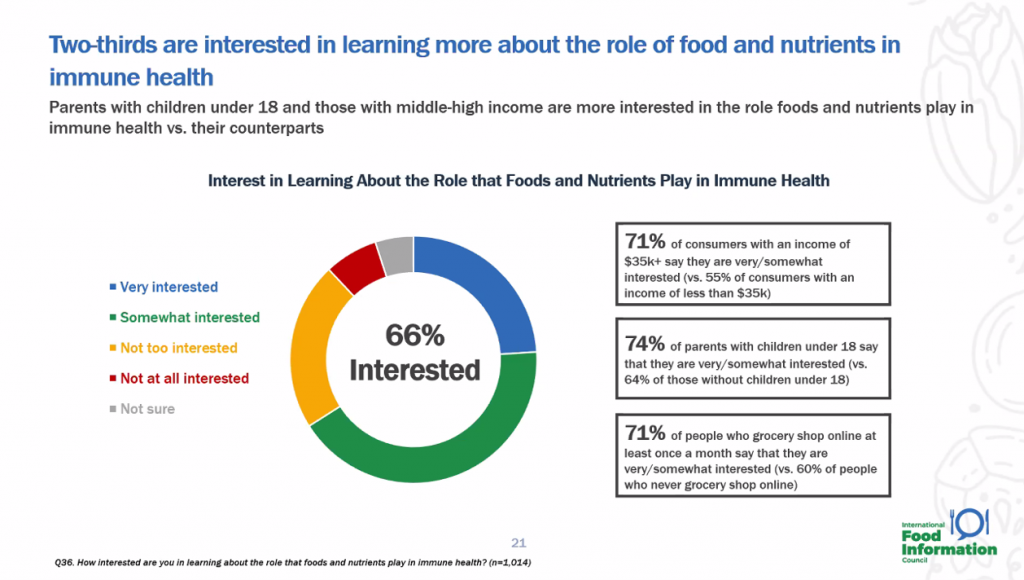 Americans are also keener on looking at food-as-medicine and health-making, as their definition of what “healthy food” is grew more positive in 2021. For example, in their definition of what a healthy food is, top of mind are foodstuffs that are “good for you,” along with items that include vegetables, fruits, nutrients, certain other health-ful components, and protein — continuing its prevalence in food consumers’ minds as an important component on the plate.
Americans are also keener on looking at food-as-medicine and health-making, as their definition of what “healthy food” is grew more positive in 2021. For example, in their definition of what a healthy food is, top of mind are foodstuffs that are “good for you,” along with items that include vegetables, fruits, nutrients, certain other health-ful components, and protein — continuing its prevalence in food consumers’ minds as an important component on the plate.
Furthermore on the protein front, one in four people in the U.S. are eating more protein from plant sources than they did a year ago. More people are also eating more seafood protein and poultry and eggs.
“Natural,” “Nutritious,” “No artificial ingredients,” and “Unprocessed” dropped in response popularity. Items with descriptors like “low sugar,” “low fat,” “low calories,” and “low carbohydrates” are popular responses but have declined in popularity over the year.
On the food-as-medicine front, we have seen fast-growth among U.S. consumers in the uptake of Vitamin D and supplements like Elderberry for boosting immunity. So IFIC found this phenomenon in their survey that 66% of U.S. consumers are interested in learning about the role that foods and nutrients play in immune health — that’s 2 in 3 people, which is a very high index in a study like this. More affluent people are interested in food-for-immunity, as well as parents with children under 18.
IFIC has been tracking the impact of the coronavirus pandemic on eating in America. This latest study provides an update to the Foundation’s recent report from March 2021 when the team looked at COVID-19’s impact on food purchasing, eating, and perceptions of food safety. These check-ins go back to June 2020 and demonstrate U.S. consumers’ changing attitudes toward food during the public health crisis.
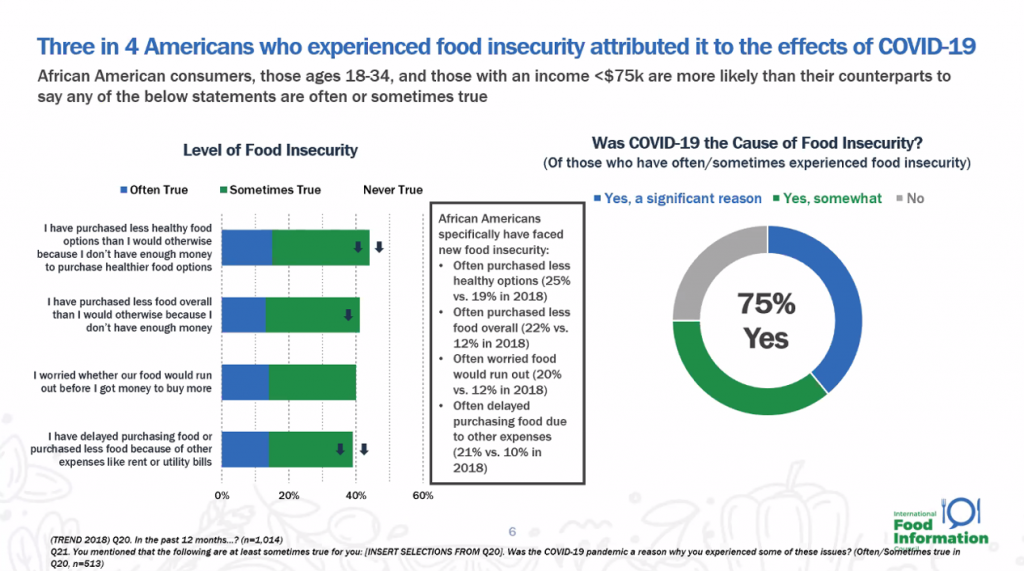
Health Populi’s Hot Points: If you paid attention to mass media since the start of the pandemic in the first quarter of 2020, then you would be aware of a toxic side-effect of the coronavirus crisis — that of food insecurity.
While food pantries and people lacking access to healthy food in their local neighborhoods was challenging for millions of people in the U.S. in 2019, the situation worsened due to the pandemic.
IFIC found that 3 in 4 Americans who experienced food insecurity blamed it on the impact of COVID-19, shown in this chart from the study.
Some of the sad fine print here is that African-Americans were more likely to face new food insecurity challenges, more having to purchase less healthy options, less food overall, and delaying buying food in order to pay other household expenses.
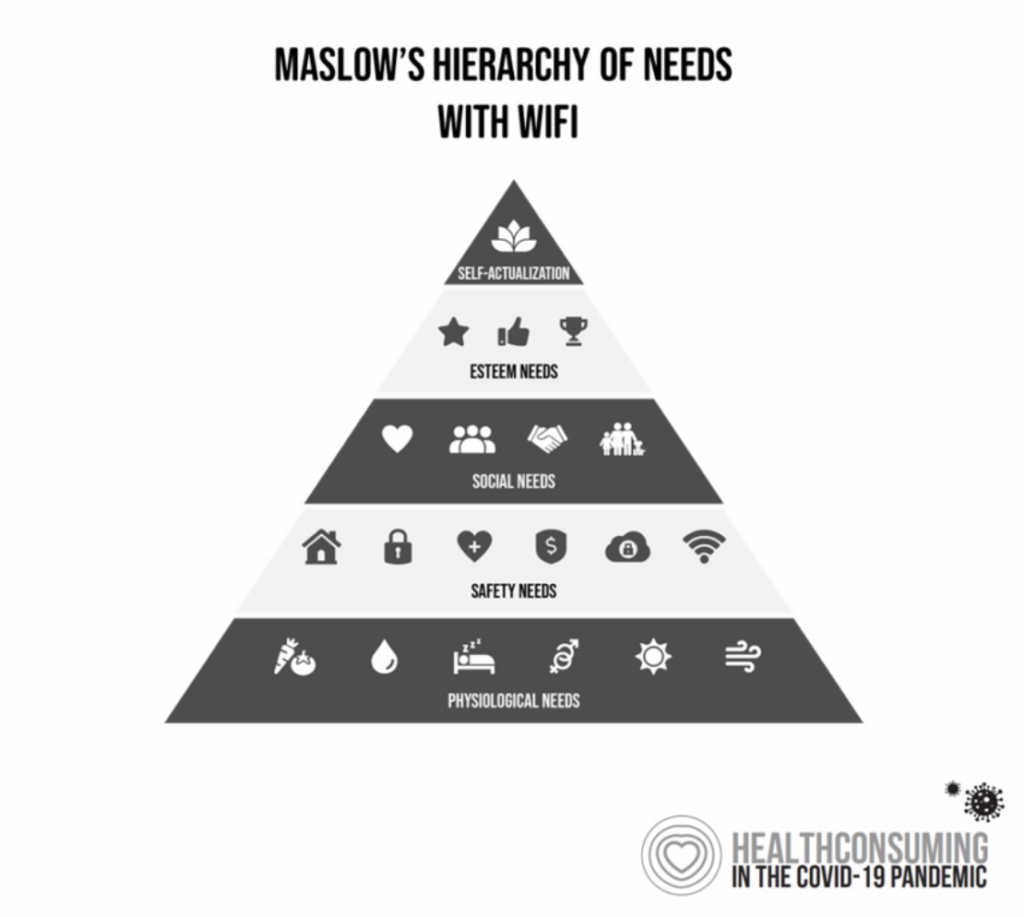 On a positive note, three-fourths of people in the U.S. have made efforts to help their communities in the past year. Nearly one-half of Americans have supported local restaurants and/or tipped servers and food delivery workers more. One in four people have looked to buy food from local farmers and one in five people volunteered or donated to a local food bank or helped people in town who needed assistance in getting food or groceries.
On a positive note, three-fourths of people in the U.S. have made efforts to help their communities in the past year. Nearly one-half of Americans have supported local restaurants and/or tipped servers and food delivery workers more. One in four people have looked to buy food from local farmers and one in five people volunteered or donated to a local food bank or helped people in town who needed assistance in getting food or groceries.
A key and moving insight here was that 86% of Americans who had experience food insecurity due to COVID-19 did something to help folks in their community in the past year.
As Maslow’s Hierarchy of Needs reminded us through the pandemic, and through today still, COVID-19 truly flattened our pyramids down to the most basic and fundamental of human needs — our physiological ones for sleep, shelter, and indeed, nutritious food as we hunted and gathered, as physical distances and via ecommerce, for groceries and hygiene products building up our pandemic pantries.
Another level of basic needs here which was critical to muddling through the pandemic was social needs seen here on the third triangle tier. So it’s gratifying to see from the IFIC study that social issues became important to millions of people in the pandemic. One data-point here stands out as we consider the food industry’s stance with respect to ESG, Environment, Social, and Governance Goals. A big “S” in the eyes of U.S. consumers was that 6 in 10 people said fair and equitable treatment of food workers was important to them.
As we continue to emerge to the brighter side of the pandemic, continuing to make health for ourselves and with our families and friends, we in the KahnCave hope that these social aspects which raised our collective consciousness during the pandemic will persist just as we keep cooking healthier at home, and choosing healthy foods to bolster our well-being.
The post Americans’ Views on Food Have Been Re-Shaped by the Pandemic: Think Security, Immunity, and Sustainability appeared first on HealthPopuli.com.
Americans’ Views on Food Have Been Re-Shaped by the Pandemic: Think Security, Immunity, and Sustainability posted first on https://carilloncitydental.blogspot.com
No comments:
Post a Comment